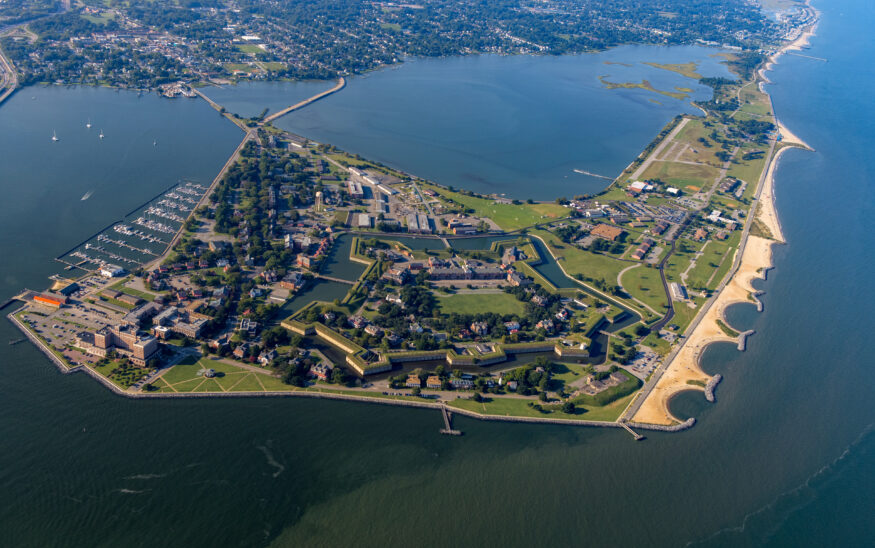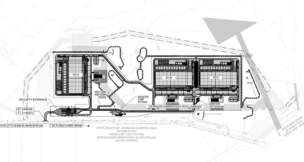Firms compete for plan to reimagine Fort Monroe
New action plan will guide site development
Josh Janney //October 24, 2025//

An aerial view of Fort Monroe. Photo Courtesy Fort Monroe Authority

An aerial view of Fort Monroe. Photo Courtesy Fort Monroe Authority
Firms compete for plan to reimagine Fort Monroe
New action plan will guide site development
Josh Janney //October 24, 2025//
SUMMARY:
Four internationally recognized design firms — including the teams behind Governors Island in New York and the landscaping for Apple Park, Apple’s corporate headquarters campus in Cupertino, California — are competing to shape the next chapter of Fort Monroe’s future.
Next year, the Fort Monroe Authority plans to develop a landscape action plan, a guiding framework to steer the future of the site. The plan will determine how the site’s remaining land is divided among commercial, residential and recreational uses, and will identify specific redevelopment projects — paving the way for new partnerships with developers and businesses to execute them.
“The first observation, when I took the job here, is that we were lacking a north star,” said Fort Monroe CEO Scott Martin, who began overseeing the site in January.
In the past, the authority would wait for developers to pitch ideas for future developments at Fort Monroe, and then it would check to see if those plans aligned with preexisting master plans.
But now Martin says that, rather than waiting for developers to bring ideas to the table, the authority will establish a clear vision first, factoring in project costs and financial sustainability. Then, after the authority forms the plan, it will seek the right partners to bring that vision to life.
While it remains to be determined how many acres could be redeveloped, the site has at least 1.5 million square feet of vacant commercial space.
Located at the southern tip of the Virginia Peninsula in Hampton, the 560-acre-plus former U.S. Army post closed in 2011 and is now cooperatively managed by the Fort Monroe Authority, a governing entity created by the General Assembly. The state owns about 318 acres of the property, while the National Park Service owns 121 acres and the U.S. Army owns 122 acres (with plans to eventually transfer it to the park service).
Once known as Old Point Comfort, Fort Monroe is steeped in centuries of American history. In 1619, it was the site where the first enslaved Africans were brought to North America. Named for President James Monroe, it was built by the U.S. Army between 1819 and 1834, with a young Robert E. Lee among those who oversaw its construction. During the Civil War, when it remained under Union control, the fort was a haven for thousands of people who escaped enslavement — a legacy that earned it the name “Freedom’s Fortress.” The Army deactivated the post in 2011, transferring many of its missions to nearby Fort Eustis in Newport News; later that year, President Barack Obama designated 325 acres of the site as a national monument.
The final four
The authority launched an international search for proposals to develop the plan earlier this summer. Nineteen firms submitted proposals by the early September deadline.
Since then, the authority has narrowed the candidates to four design firms: West8, Olin Studio, Field Operations and Hargreaves Jones.
The finalists all have high-profile projects under their belt. West8 transformed a former military base at Governors Island in New York into a lush public park; Olin Studio designed the landscape for Apple’s headquarters in California; Field Operations designed the 1.5-mile-long High Line in New York; and Hargreaves Jones was involved with the landscape design of Queen Elizabeth Olympic Park in London.
A special jury — including design and landscape deans and directors from Virginia Tech, the University of Virginia and Hampton University, as well as state preservation and cultural landscape leaders — will recommend one of the firms to the authority.
The authority is expected to decide who to choose before the end of the year, likely in November, with design work beginning in January 2026. The goal is to have the plan about 80% complete by August 2026 and finished by the end of the year.
“And then the whole plan on this, this is not to sit on the shelf,” Martin said. “You come out of this with a capital campaign strategy. This plan, if you’re doing it well, it begins to turn into development projects shortly thereafter, with a capital campaign that runs alongside it. So, you move from big idea to big action.”
A reimagined Fort Monroe
The Fort Monroe Authority’s new plan will address oversights in its 2013 land use master plan and earlier plans, which, Martin said, no longer reflect current realities, such as the region’s housing challenges, sea-level rise, changing work patterns or ongoing projects the fort has developed since, like the African Landing Memorial.
The new plan will cover everything from business development, pedestrian trails and adaptative reuse of historic buildings to shoreline resilience and tree planting. Martin said a challenge will be determining whether vacant buildings are best repurposed for commercial, multifamily or hotel uses.
“Every one of those different decisions has ripples that then roll across the rest of the site, and you can’t make these decisions in a vacuum, because you lose the forest for the trees,” he said.
One of the most notable sites at Fort Monroe being eyed for redevelopment is Old Point Comfort Marina. Smithfield-based hospitality management company Pack Brothers has plans to redevelop the site into 37 North at Fort Monroe, a forthcoming waterfront resort featuring a 90-room boutique hotel, marina and 500-seat seafood restaurant. The project was put on hold in early 2024 due to rising costs, but managing partner Randy Pack said that his company is still diligently pursuing the project, with hopes to see development begin within the next couple years.
Aazia Mrozinski, executive director of the authority’s nonprofit partner, the Fort Monroe Foundation, noted that the authority and foundation aim to heavily involve the community and stakeholders in forming the action plan.
While Martin hopes the plan honors the history of the site, he also wants to dispel the notion that the fort is “finished” and reframe it as a living, evolving place.
“This site is far from done making history,” he said.
l
















